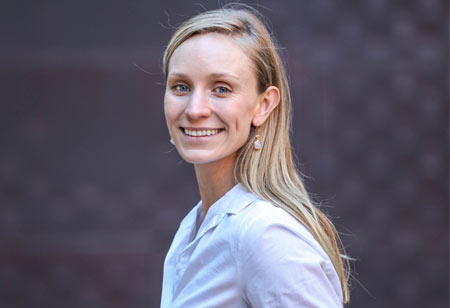Luke Peterson’s fields at A-Frame Farm in Madison, Minnesota, stand in striking contrast to his neighbors’. Surrounding Luke’s vibrant and diversified plots of sunflowers, buckwheat, flax, perennial wheat, and several other crops that make up his 15+ species rotation are miles of corn and soy. There’s good reason for the steady dominance of corn and soy across the Midwest: robust market demand, strong insurance protections in case of crop failure and weather disasters, and a historical focus on specialization to maximize output, for starters. This reliance on a small handful of crops is characteristic of our global food system, where just four crops account for more than 50 percent of agricultural production, and just three crops account for 50 percent of our calories. These dominant crops can and do play important roles in our ecosystems and diets, but our overreliance on a narrow set of ingredients is threatening planetary and human health.
Biodiversity—the intricate web of life in a given geography—is a cornerstone of ecosystem health. Fostering a wide variety of plants and animals can build a habitat for the creatures that pollinate and sustain our food supply, provide the building blocks for medicinal discoveries, regulate our climate, and clean our water, among a litany of other benefits. Yet, human activities, including the way we produce food, are putting one million species at risk of extinction. From a dietary standpoint, eating a diverse mix of plants is increasingly being recognized as critical for gut microbiome health and ensuring the consumption of a broad mix of important nutrients. In our concentrated model, Americans face significant nutrient deficiencies, with more than 90 percent of Americans being deficient in fiber and vitamin D and over 30 percent of Americans being deficient in calcium. Our homogenous food system is leaving the health of ecosystems and humans at risk.
We all have a role to play in making our food system more vibrant and heterogeneous
Luke, a first-generation farmer with a fervent interest in the intersection of human and planetary health, is disrupting this paradigm. By rotating his fields with livestock and a panoply of assorted crops, he’s cultivating much more than plants and animals; he’s building rich soil capable of growing food for the next generations, he’s storing water deep in the soil by choosing crops with long taproots, he’s using perennial plants to pull carbon from the atmosphere into the soil, and he’s expanding the array of ingredients—and therefore nutrients and flavors—hitting consumer shelves. The success of Luke’s farm and other farms prioritizing diversified rotations hinges on the existence of strong market demand for a broad offering of crops. This is where food companies come in: what if food manufacturers and retailers asked farmers what they wanted to grow? What if innovation in the food industry was guided by farmers and their deep knowledge of what their land needs? What if we heeded farmer insights as input to our food design process in the same way we prioritize consumer insights?
This is the journey we’re on at Simple Mills, a food company on a mission to revolutionize the way food is made to nourish people and the planet. Conversations with Luke and countless other leading-edge farmers have significantly shaped our innovation, bringing planetary health and nutrient density on par with taste and texture in our design process. The watermelon seed flour in our Seed and Nut Flour Sweet Thins was the result of conversations with farmers who wanted to help revive a 3,000-year-old variety of watermelon grown for its seeds rather than its flesh. The buckwheat in our Sandwich Cookies was inspired by farm visits to growers who championed the pseudocereal’s ability to make phosphorous bioavailable in the soil. The red beans in our Pop Mmms Veggie Flour Baked Snack Crackers were motivated by deepening our appreciation for the role of legumes in fixing nitrogen in the soil while simultaneously providing a shortfall nutrient—fiber—to eaters. Spending more time learning from farmers has not only enhanced our ability to help farmers diversify their fields but also the creativity of our innovation process and the variety of nutrients and flavor experiences we’re able to offer our consumers.
The concept of diversifying farm fields with a variety of crops is not new. Indigenous communities have been championing crop diversity and seed preservation for generations through techniques like planting the ‘three sisters’ crops in tandem—corn, beans, and squash, which all play different roles in the farm ecosystem. We stand to learn a lot from these communities and farmers, elevating the importance of crop diversity. We all have a role to play in making our food system more vibrant and heterogeneous. If you’re an eater, you might seek out an ingredient at the grocery store you’ve never tried. If you work for a food company, you might get on the phone with a farmer and ask what crops they want to grow, but for which they don’t have a strong market. If you’re a home gardener or a farmer, you might reserve a small test plot for a crop or variety you haven’t grown before. These ostensibly small acts can send big signals and might just create a ripple effect that leads us toward a food system with more variety, flavor, and resilience.


